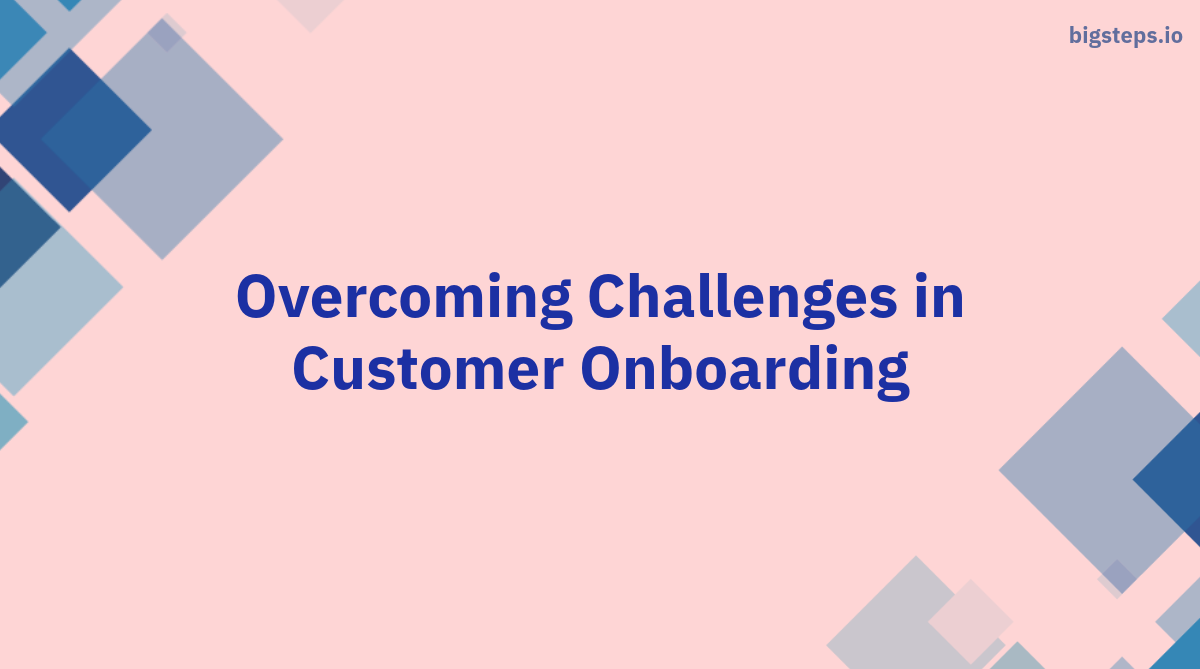Overcoming Challenges in Customer Onboarding
Read Time 3 mins | Written by: Vaibhav Awachat

Discover how to overcome the challenges faced in customer onboarding and ensure a seamless implementation process.
Creating a Seamless Customer Onboarding Experience
Creating a seamless customer onboarding experience is crucial for businesses to successfully onboard new customers. It involves a series of steps and interactions that aim to make the transition from prospect to customer as smooth as possible. One challenge in creating this seamless experience is the increasing complexity of products and services. As businesses offer more advanced solutions, the onboarding process becomes more intricate, requiring more time and effort to educate customers and help them understand how to use the product or service effectively.
Another challenge is the need for personalized onboarding experiences. Customers have different needs, preferences, and levels of expertise, and it is important to tailor the onboarding process to meet their specific requirements. This requires a deep understanding of the customer's goals and pain points, as well as the ability to customize the onboarding journey accordingly. Personalization can help reduce friction and increase customer satisfaction during the onboarding process.
Additionally, the onboarding process may face challenges due to internal organizational issues. Lack of alignment between different departments or teams involved in the onboarding process can lead to delays and miscommunication. It is essential to have clear roles, responsibilities, and processes in place to ensure a smooth handover of customers from the sales team to the implementation team. Effective collaboration and coordination between teams can help overcome these challenges and streamline the onboarding process.
Overcoming Challenges in Customer Onboarding
To overcome the challenges faced in customer onboarding, businesses can take several steps. Firstly, they can invest in comprehensive training and education programs for their customers. By providing resources such as user manuals, tutorials, and online courses, businesses can empower customers to learn and navigate their products or services independently. This can reduce the dependency on support teams and enable a self-service onboarding experience.
Another strategy is to implement effective communication strategies throughout the onboarding process. Regular and transparent communication helps set clear expectations, address any concerns or questions, and provide timely updates on the progress of the implementation. This help in building trust and confidence in the customer and ensure a positive onboarding experience.
Leveraging technology can greatly streamline the onboarding process. Businesses can utilize customer onboarding software, automation tools, and digital platforms to automate repetitive tasks, track progress, and provide real-time visibility into the implementation process. This not only saves time and effort but also improves accuracy and consistency in customer onboarding.
Lastly, measuring success and continuously improving the onboarding process is essential. Businesses should establish key performance indicators (KPIs) to track the effectiveness of their onboarding efforts. Feedback from customers should be collected and analyzed to identify areas for improvement.
Implementing effective communication strategies
Clear and timely communication helps set expectations, address concerns, and build trust between the business and the customer. One strategy is to establish a communication plan that outlines the frequency and channels of communication throughout the onboarding journey. This ensures that both parties are aligned and aware of the progress and next steps.
Another strategy is to provide personalized communication based on the customer's preferences. Some customers may prefer email updates, while others may prefer phone calls or in-person meetings. Understanding their communication preferences and adapting accordingly can enhance the onboarding experience.
Additionally, businesses can leverage technology to facilitate communication. Implementing a customer onboarding platform or using project management tools can help centralize communication, track conversations, and ensure that all relevant stakeholders are involved. This improves collaboration and reduces the chances of miscommunication or missed updates.
Overall, effective communication strategies foster transparency, build rapport, and ensure that the customer feels supported and informed throughout the onboarding process.
Leveraging technology for streamlined onboarding
Leveraging technology is key to streamlining the customer onboarding process. Technology can automate repetitive tasks, improve efficiency, and enhance the overall onboarding experience. One way to leverage technology is by implementing a customer onboarding software. This software can automate tasks such as sending welcome emails, collecting customer information, and tracking progress. It can also provide a centralized platform for collaboration and communication between different teams involved in the onboarding process.
Another technology that can be leveraged is automation tools. These tools can automate manual processes, such as data entry or document generation, saving time and reducing errors. Automation can also trigger personalized communication based on specific events or milestones achieved during the onboarding process.
Also, businesses can leverage digital platforms to provide self-service onboarding resources. Online tutorials, knowledge bases, and video demonstrations can empower customers to learn and onboard at their own pace. This reduces dependency on support teams and enables a more efficient onboarding process.
By leveraging technology effectively, businesses can streamline the onboarding process, reduce manual effort, and enhance the overall customer experience.
Measuring success and continuous improvement
Measuring success and continuously improving the onboarding process is crucial for long-term success. Businesses should establish key performance indicators (KPIs) to track the effectiveness of their onboarding efforts. These KPIs can include customer satisfaction scores, time to onboard, and retention rates. Regularly monitoring these metrics helps identify areas for improvement and allows businesses to make data-driven decisions.
Collecting feedback from customers is another important aspect of measuring success. Surveys, interviews, and feedback forms can provide valuable insights into the customer's experience during onboarding. Analyzing this feedback helps businesses understand pain points, identify bottlenecks, and make necessary improvements.
Additionally, businesses should foster a culture of continuous improvement. This involves regularly reviewing and refining the onboarding process based on insights and feedback. Collaboration between different teams, sharing best practices, and implementing innovative solutions are key to driving continuous improvement.
By measuring success and continuously improving the onboarding process, businesses can enhance customer satisfaction, increase customer retention, and drive long-term growth.
